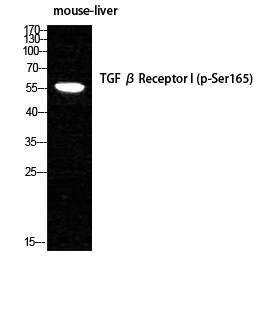产品名称
TGFβ RI (phospho Ser165) Rabbit Polyclonal Antibody
别名
TGFBR1; ALK5; SKR4; TGF-beta receptor type-1; TGFR-1; Activin A receptor type II-like protein kinase of 53kD; Activin receptor-like kinase 5; ALK-5; ALK5; Serine/threonine-protein kinase receptor R4; SKR4; TGF-beta type I receptor; Transfor
蛋白名称
TGF-beta receptor type-1
存储缓冲液
Liquid in PBS containing 50% glycerol, 0.5% BSA and 0.02% New type preservative N.
Human Gene Link
http://www.ncbi.nlm.nih.gov/sites/entrez?db=gene&term=7046
Human Swissprot No.
P36897
Human Swissprot Link
http://www.uniprot.org/uniprotkb/P36897/entry
Mouse Gene Link
http://www.ncbi.nlm.nih.gov/sites/entrez?db=gene&term=21812
Mouse Swissprot No.
Q64729
Mouse Swissprot Link
http://www.uniprot.org/uniprot/Q64729
Rat Swissprot Link
http://www.uniprot.org/uniprot/P80204
免疫原
The antiserum was produced against synthesized peptide derived from human TGF beta Receptor I around the phosphorylation site of Ser165. AA range:131-180
特异性
Phospho-TGFβ RI (S165) Polyclonal Antibody detects endogenous levels of TGFβ RI protein only when phosphorylated at S165.
稀释度
WB 1:500-2000, IF 1:50-300, IHC 1:50-300
宿主
Polyclonal, Rabbit,IgG
背景介绍
The protein encoded by this gene forms a heteromeric complex with type II TGF-beta receptors when bound to TGF-beta, transducing the TGF-beta signal from the cell surface to the cytoplasm. The encoded protein is a serine/threonine protein kinase. Mutations in this gene have been associated with Loeys-Dietz aortic aneurysm syndrome (LDAS). Multiple transcript variants encoding different isoforms have been found for this gene. [provided by RefSeq, Aug 2008],
组织表达
Found in all tissues examined, most abundant in placenta and least abundant in brain and heart. Expressed in a variety of cancer cell lines (PubMed:25893292).
细胞定位
Cell membrane ; Single-pass type I membrane protein . Cell junction, tight junction . Cell surface . Membrane raft .
信号通路
MAPK_ERK_Growth;MAPK_G_Protein;Cytokine-cytokine receptor interaction;Endocytosis;TGF-beta;Adherens_Junction;Pathways in cancer;Colorectal cancer;Pancreatic cancer;Chronic myeloid leukemia;
功能
catalytic activity:ATP + [receptor-protein] = ADP + [receptor-protein] phosphate.,cofactor:Magnesium or manganese.,disease:Defects in TGFBR1 are the cause of aortic aneurysm familial thoracic type 5 (AAT5) [MIM:608967]. Aneurysms and dissections of the aorta usually result from degenerative changes in the aortic wall. Thoracic aortic aneurysms and dissections are primarily associated with a characteristic histologic appearance known as 'medial necrosis' in which there is degeneration and fragmentation of elastic fibers, loss of smooth muscle cells, and an accumulation of basophilic ground substance.,disease:Defects in TGFBR1 are the cause of Loeys-Dietz syndrome type 1A (LDS1A) [MIM:609192]; also known as Furlong syndrome or Loeys-Dietz aortic aneurysm syndrome (LDAS). LDS1 is an aortic aneurysm syndrome with widespread systemic involvement. The disorder is characterized by arterial tortuosity and aneurysms, craniosynostosis, hypertelorism, and bifid uvula or cleft palate. Other findings include exotropy, micrognathia and retrognathia, structural brain abnormalities, intellectual deficit, congenital heart disease, translucent skin, joint hyperlaxity and aneurysm with dissection throughout the arterial tree.,disease:Defects in TGFBR1 are the cause of Loeys-Dietz syndrome type 2A (LDS2A) [MIM:608967]. LDS2 is an aortic aneurysm syndrome with widespread systemic involvement. Physical findings include prominent joint laxity, easy bruising, wide and atrophic scars, velvety and translucent skin with easily visible veins, spontaneous rupture of the spleen or bowel, diffuse arterial aneurysms and dissections, and catastrophic complications of pregnancy, including rupture of the gravid uterus and the arteries, either during pregnancy or in the immediate postpartum period. LDS2 is characterized by the absence of craniofacial abnormalities with the exception of bifid uvula that can be present in some patients.,function:On ligand binding, forms a receptor complex consisting of two type II and two type I transmembrane serine/threonine kinases. Type II receptors phosphorylate and activate type I receptors which autophosphorylate, then bind and activate SMAD transcriptional regulators. Receptor for TGF-beta.,PTM:Phosphorylated at basal levels in the absence of ligand binding. Activated by multiple phosphorylation, mainly in the GS region.,similarity:Belongs to the protein kinase superfamily.,similarity:Belongs to the protein kinase superfamily. TKL Ser/Thr protein kinase family. TGFB receptor subfamily.,similarity:Contains 1 GS domain.,similarity:Contains 1 protein kinase domain.,subunit:Interacts with CD109. The unphosphorylated protein interacts with FKBP1A and is stabilized the inactive conformation. Phosphorylation of the GS region abrogates FKBP1A binding. Interacts with SMAD2 when phosphorylated on several residues in the GS region.,tissue specificity:Found in all tissues examined, most abundant in placenta and least abundant in brain and heart.,
纯化
The antibody was affinity-purified from rabbit antiserum by affinity-chromatography using epitope-specific immunogen.
polbd-p-ihc-human-liver.jpg)
polbd-p-ihc-rat-kidnebd-p.jpg)
polbd-p-ihc-rat-spleen.jpg)

